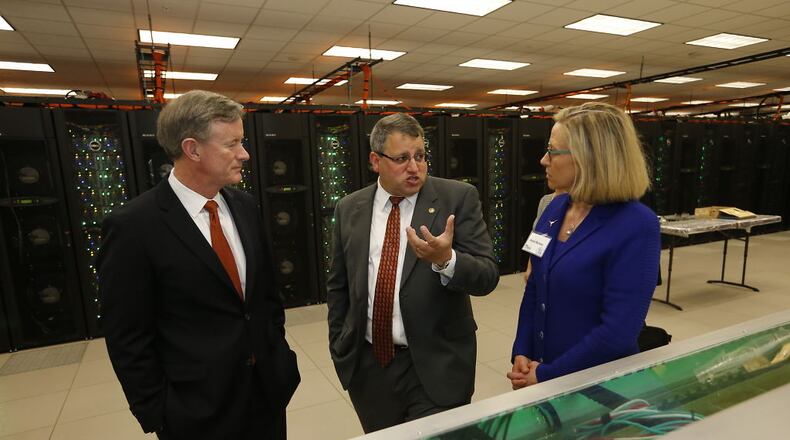When it comes into full operation, Stampede 2 will double the performance of TACC’s current supercomputer, Stampede 1, and serve thousands of scientists around the country and internationally. The new computer is expected to be among the most powerful machines in the country available academic researchers involved in physical sciences, biological sciences, social sciences and advanced engineering.
The announcement coincides with the dedication of a $20 million expansion building for TACC, which accommodates the center’s rapid growth, includes an auditorium for large gatherings, a training center for a broad range of classes and a data visualization center to help scientists get a better grasp of their research data. The expansion was paid for in part with funds from Dallas-based O’Donnell Foundation, a longtime supporter of computer-related research at UT.
Both the Stampede 2 announcement and the expansion are further evidence of TACC’s rise over the past 15 years from modest beginnings to a world-class center for academic computing.
Stampede 2 will be built with hardware supplied by chipmaker Intel Corp., Round Rock-based Dell Inc. and Seagate Technology, which makes data storage systems. All three companies will help TACC in the complex job of building the computer and putting it into operation.
Stampede 2 will be completed in several phases over the next year and it is expected to be in nearly continuous operation until late 2021.
How fast will the new computer really be? Those involved with the project say its performance could reach 18-20 "petaflops" -- a petaflop equals a million-billion basic math calculations per second.
Stampede 2 is expected to rank among the top handful of "open science" computers in the world. TACC officials say only that they expect it will be the most powerful university-operated computer in the country.
Computer scientists and engineers at TACC will have the main job of running the new computer with specialized help from other technical experts at the UT, Clemson University, Cornell University, the University of Colorado at Boulder, Indiana University and Ohio State University.
TACC has expanded to about 135 full-time staffers and another 25 part-timers who are students.
Its workload has expanded well beyond the job of running thousands of computer jobs on complex systems. TACC assists academic researchers in building software applications that make better use of its systems. It also helps researchers safely store, manage, visualize and share their troves of research data.
Irene Qualters, National Science Foundation division director for advanced cyberinfrastructure, congratulated the TACC team on the new project and its past successes. There have been technical challenges along the way, she said.
"There have been times when I have had some doubts about whether TACC could really pull it off in spite of your being Texans," she said with a smile. "TACC has positioned itself for the future and we are grateful for that. We applaud the staff of TACC -- innovative, dedicated, scrappy and tested -- for the unique role you play in exploring, developing, deploying and operating critical infrastructure for research."
The National Science Foundation is the leading backer of large-scale supercomputers for university research in the United States. The agency sent a review team to Austin to do a thorough study of the operations of Stampede to make certain TACC was qualified for the new project.
Dan Stanzione, executive director of TACC, said the existing Stampede 1 system has run more than 7 million advanced computer simulations and data analysis jobs for tens of thousands of users in the since it started operation in 2013.
“The kind of large-scale computing and data capabilities that systems like Stampede and Stampede 2 provide are crucial for innovation in almost every area of research and development. They provide insights to fundamental research and to applied work that has near-term impacts on society," he said.
"Stampede has been used for everything from determining earthquake risks to help set building codes for homes and commercial buildings. It also has provided the computing for the largest mathematical proof ever constructed."
But, Stanzione said, it is time for an upgrade.
"Supercomputers get old just like your laptop computer does," Stanzione said at Thursday's dedication ceremony. "So we want a new one."
About the Author

